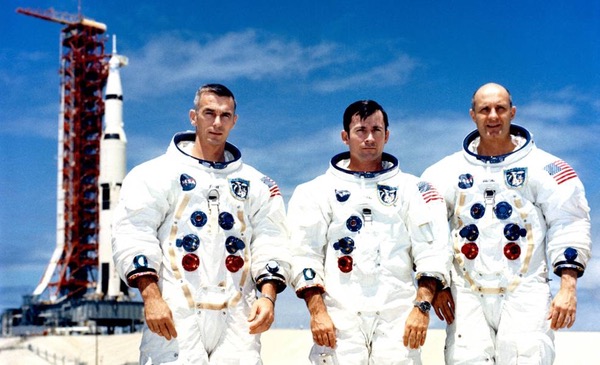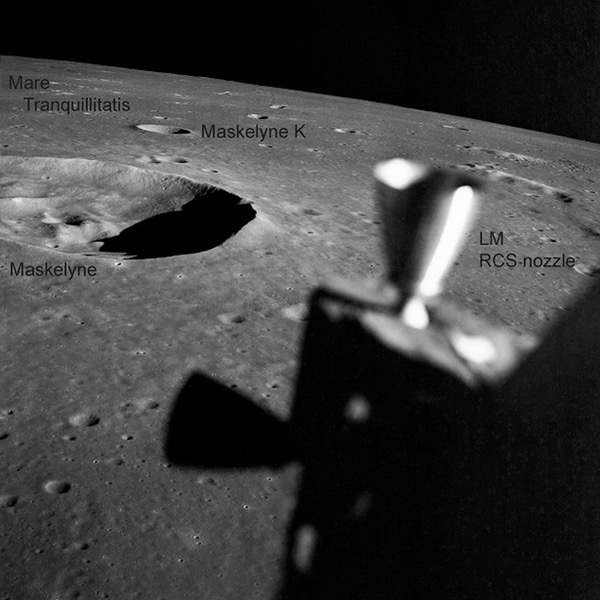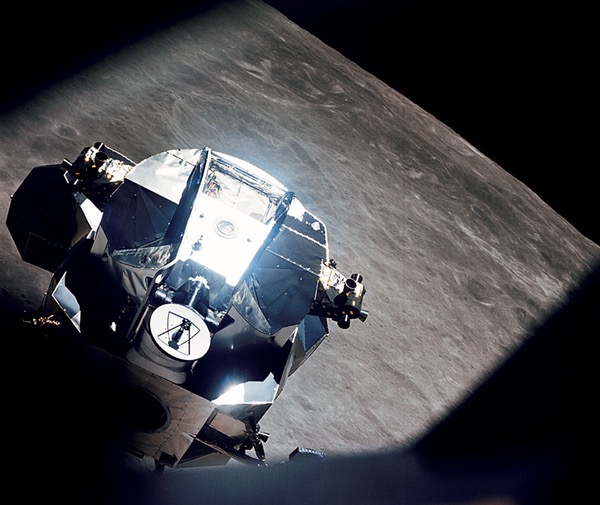Apollo 10: “To sort out the unknowns” for Apollo 11by Anthony Young
|
| If Apollo 10 went well, then America could move forward with its goal of landing men on the Moon with Apollo 11 before the end of the decade. |
Originally, NASA had scheduled Apollo 8 to conduct comprehensive tests of the lunar module and its ability to undock, rendezvous, and dock with the command and service modules (CSM-103) in Earth orbit. When it became clear that Grumman’s lunar module LM-3 would not be ready in time, NASA decided to instead send the crew on a lunar orbit mission. The Apollo 8 mission in December 1968 was a spectacular success (see “Apollo 8: humanity’s first voyage to the Moon”, The Space Review, December 16, 2013).
Meanwhile, LM-3, now scheduled for Apollo 9, arrived at Kennedy Space Center (KSC) in June 1968 for months of inspection, checkout, and other vital tests. The three stages of the Saturn V, AS-504, started arriving in May 1968 and the command and service modules (CSM-104) followed in October. The crew of Apollo 9 of James McDivitt, David Scott and Russell Schweickart was launched March 3, 1969 (see “Apollo 9: testing the lunar module”, The Space Review, March 3, 2014). This ten-day Earth orbit mission was also a success, achieving all mission milestones. The launch of Apollo 10 remained on schedule for mid-May.
 The crew of Apollo 10 had all flown on Gemini missions. They were (from left to right) Eugene Cernan, John Young, and Thomas P. Stafford. (credit: NASA) |
The Apollo 10 crew and flight hardware
The three crewmembers assigned to Apollo 10 were all veterans of the Gemini program. Thomas P. Stafford, the mission commander, had flown on Gemini 6 in December 1965 with Wally Schirra. Stafford flew again on Gemini 9 in June of 1966. Apollo 10 lunar module pilot Eugene Cernan flew alongside Stafford on Gemini 9; on that mission, Cernan performed a spacewalk lasting more than two hours. The Apollo 10 command module pilot was John Young, who had flown Gemini 3 in March 1965 and again on Gemini 10 in July 1966.
The Apollo 10 spacecraft began arriving at KSC in October 1968. The LM-4 descent stage arrived at KSC from Grumman on October 11, and the ascent stage followed five days later. The LM-4 stages were mated on November 2 and the spacecraft underwent comprehensive systems testing. North American Aviation delivered the command and service modules of CSM-106 on November 23. The lunar module was code-named Snoopy and the command module was appropriately nicknamed Charlie Brown.
Four days later, the SA-505 S-IC first stage was delivered to the Vehicle Assembly Building (VAB) at KSC. The S-II second stage and S-IVB third stage were delivered in early December, with the instrument unit shortly thereafter. The mating of the stages on the mobile launch platform (MLP) was completed on December 30.
CSM-106 was moved to the VAB in early February. LM-4 was secured inside the tapered lunar module adapter and CSM-106 was secured to the lunar module adapter on February 6. The complete launch vehicle and spacecraft underwent several more weeks of crucial tests. On March 11, MLP-3, bearing the Apollo 10 space vehicle, moved to Launch Complex 39B. This would be the first manned Saturn V launch from 39B, as both Apollo 8 and 9 launched from 39A.
While the space vehicle underwent two more months of tests, the crew of Apollo 10 spent many hours in mission simulators going over not only every step in the mission profile, but also failure simulations and what to do in that event.
Countdown, launch, and go for trans-lunar injection
The launch of Apollo 10 was scheduled for 12:49 pm Eastern time on May 18, 1969. During the one-hour scheduled hold at T-minus 3 hours 30 minutes, workers replaced a blown fuse in a ground-based liquid oxygen replenish pump, but otherwise the countdown continued smoothly. At ignition sequence start, the five massive F-1 engines ignited and built up to their operating thrust. The hold-down arms released the S-IC stage and the mighty Saturn V lifted off precisely on time.
| “I got the Moon’s reflected surface in the LM window,” Cernan declared as he looked out a CM window. “God, that Moon is beautiful. We’re right on top of it.” |
There were no anomalies during operations of the first, second, or third stages during the ascent to orbit. Although the ascent phase of the Saturn V was a violent experience for most astronauts, the dynamics were well within the structural capabilities of the vehicle, as documented in the AS-505 flight evaluation report.
As the S-IVB stage and spacecraft orbited Earth, all systems were checked and the flight director received the unanimous “Go, flight” for the trans-lunar injection burn, relayed to the crew by flight Capcom, Charlie Duke. “Roger, 10. You’re go for TLI. S-IVB is looking as planned,” Duke affirmed.
At 2:33:27.52 mission elapsed time (MET), the S-IVB stage ignited again for a 343-second burn to break free of Earth’s gravity and send the spacecraft to the Moon.
At just over three hours into the mission, command module pilot John Young performed the separation of the S-IVB stage from the CSM, then turned the spacecraft around and docked with the lunar module. After extracting the lunar module, Young moved the spacecraft a sufficient distance from the third stage. Following commands from the ground, the stage then vented its remaining propellants, sending it past the Moon for a lunar gravity assist into a solar orbit.
During their trip to the Moon, the crew performed a live television broadcast from the command module. The spacecraft was reoriented for a televised image of the Earth during the outbound leg of their mission, broadcast by news networks around the world.
Testing the lunar module at the Moon
The service propulsion engine was scheduled to fire for 356 seconds at 75 hours, 55 minutes, and 54 seconds into the mission, during its pass behind the Moon, to insert the combined spacecraft into it preliminary lunar orbit. That was designed to duplicate the same sequence and orbital path for Apollo 11.
“I got the Moon’s reflected surface in the LM window,” Cernan declared as he looked out a CM window. “God, that Moon is beautiful. We’re right on top of it.”
The SPS engine shut down precisely 5 minutes and 56 seconds after ignition. It would be another 20 minutes and 52 seconds before Mission Control would reacquire transmission from the spacecraft coming around the far side of the Moon. During this hectic time, the crew stole quick glances out the CM window when the spacecraft was oriented to permit view of the Moon below.
“I just don’t know what to think of that,” Young marveled at the lunar surface below. “That is just fantastic. These mountains look like they’ll reach right up here at us… this is a little, bitty planet.”
While in lunar orbit, the crew conducted another live television broadcast at 80 hours and 44 minutes into the mission. They televised and described the features of the lunar surface below during this broadcast, which was carried by CBS News with Walter Cronkite.
After two orbits, the engine fired again for just under 14 seconds to circularize the orbit around the Moon. Cernan entered the LM at 81 hours, 55 minutes, to conduct systems and communications checks that took roughly two hours, then he returned to the command module.
| “Keep up the good work, boys,” Young told his crewmates. “You will never know how big this thing gets when there ain’t nothing in here but one guy.” |
Then, at just over 95 hours into the mission, Cernan and Stafford entered the LM to begin preparations for undocking. Although the two spacecraft were docked 3.5 degrees off from perfect alignment, Houston assured the crew this was not a problem. Some three and a half hours later, Stafford undocked Snoopy from Charlie Brown using the lunar module’s reaction control system (RCS). Cernan and Stafford deployed the landing gear, and methodically checked the spacecraft’s systems prior to the next phase.
Young performed an 8.3-second RCS burn to move the CSM about ten meters from the lunar module. The LM performed a slow pirouette so Young could inspect the spacecraft and report his observations. Cernan performed a photographic milestone: he photographed the CSM from the LM during their lunar orbit. Photographs of the lunar surface would soon follow, but Stafford and Cernan struggled with the film magazine in their Hasselblad camera.
In one of his uncharacteristic displays of humor, Young commented on what it was like in the command module with Stafford and Cernan gone:
“Keep up the good work, boys. You will never know how big this thing gets when there ain’t nothing in here but one guy.”
The LM performed the descent orbit insertion burn at 99:46:01 MET, as would be performed on Apollo 11. This eventually put the lunar module in an orbit of 112.8 by 15.7 kilometers (60.9 by 8.5 nautical miles) that took the crew directly over Landing Site No. 2, the target assigned to Apollo 11. Stafford and Cernan kept up the commentary of their observations and occasional excited expletive as they identified craters and other features, including massive boulders on the surface and in craters.
At the lowest orbital point of the LM, the spacecraft, Cernan to remarked to Young, “I tell you, babe, we is getting down among ‘em!”
 This photo by Eugene Cernan shows the breathtaking low altitude of the lunar module as it approaches Mare Tranquilitatis and Maskelyne crater. (credit: Apollo 10 Flight Journal) |
Snoopy misbehaves and runs home to Charlie Brown
The next two hours featured a descent engine burn, ascent stage separation from the descent stage, and ascent engine burn to return the spacecraft to an orbit where Stafford and Cernan could rendezvous with Young. During the test of the abort guidance system, the two modes were “attitude hold” and “automatic.” In automatic, the computer was programed to search for and lock onto the command module.
Suddenly the LM started gyrating, startling Stafford and Cernan. Stafford performed the stage separation and then struggled to get the ascent stage oriented correctly. The problem was a result of the abort guidance system being left in automatic mode. A later investigation concluded that the switch was correctly set, then incorrectly flipped by one of the crew. With the situation back under control, the ascent stage fired and, slowly, the command module came into view. Young had been following their progress all along.
On a mission with many firsts for Apollo, the first rendezvous and docking of the CSM and LM in lunar orbit took place, with docking completed 106:22:02 MET. The twelve locking latches securing the command module to the lunar module were reassuringly loud to all three astronauts and even those in mission control.
“Hello, Houston,” Stafford reported. “Snoopy and Charlie Brown are hugging each other.”
This phase of the mission was a complete validation of the closely calculated orbital mechanics, rendezvous docking radar, and piloting skill of the astronauts. The engineering teams at North American Aviation and Grumman were elated. Their spacecraft performed perfectly. Stafford made an interesting observation that he recorded during the technical debriefing back on Earth:
“John hit the drogue right in the dead center. There was never a mark on that whole drogue."
After pressurizing the tunnel between the spacecraft, the docking probe and drogue was disengaged and removed to clear the tunnel. Stafford and Cernan transferred the precious film magazines to Young in the command module. Young was glad to have the company.
| Apollo 10 demonstrated the essential element of human involvement in the Apollo program. |
At 108 hours, 24 minutes, and 37 seconds MET, Stafford threw the toggle switch that fired the explosive ring charge in the docking collar, separating the two spacecraft. The LM quickly moved away, and its departure was recorded on the command module 16mm film camera. Twenty-eight minutes later, Mission Control sent the command to the LM for the ascent stage to fire to depletion, eventually sending the spacecraft into a solar orbit so that it would not pose a collision risk for Apollo 11.
There was still more on the mission manifest for Apollo 10. The crew would continue to orbit the Moon to conduct landmark tracking and additional lunar surface stereo and oblique photography. An SPS burn of just under 165 seconds at 137 hours, 39 minutes and 13.7 seconds into the mission finally sent the CSM hurtling back toward Earth.
The green light for Apollo 11
Charlie Brown splashed down under its canopy of three parachutes on May 26, bringing the mission of Apollo 10 to a successful end. Stafford, Cernan and Young were aboard the recovery ship USS Princeton less than 40 minutes later.
By then, SA-505 was already at LC-39A undergoing launch vehicle and spacecraft checks for the launch of Apollo 11. Apollo 10 was successful in proving a multitude of spacecraft operations, including communications between two spacecraft and Mission Control, validation of several radar systems and the tracking network, and computer operations. It also gathered vital landing site photographs and demonstrated the essential element of human involvement in the Apollo program.
John Young would go on to command Apollo 16, the first shuttle mission STS-1, and later the first Spacelab mission, STS-9. Eugene Cernan would command Apollo 17, America’s last human mission to the Moon in the 20th century. Thomas Stafford commanded the Apollo-Soyuz Test Project mission in 1975.
The Apollo 10 capsule Charlie Brown is on display in the London Science Museum.
